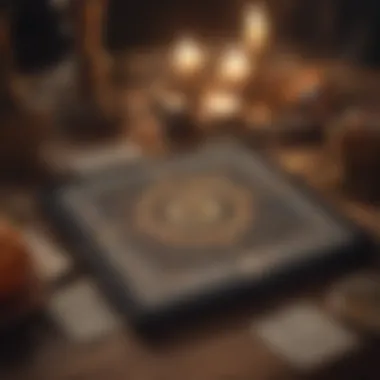Discovering the Top Tarot Card Meaning Apps


Intro
In recent years, tarot card meaning applications have gained popularity among both novices and seasoned practitioners. The integration of technology into tarot readings allows for greater access and convenience. Users can quickly reference card meanings and explore interpretations that were once confined to books or mentor guidance. This surge in interest has ushered in various applications, each offering unique features and functionalities.
Understanding these digital tools is essential for anyone looking to deepen their tarot practice. Different applications provide varied insights, ranging from basic meanings to comprehensive spreads analysis. Users have the opportunity to engage with tarot in a manner that suits their personal style and learning preference.
As we dive into the available apps, we will evaluate their strengths and weaknesses. This exploration aims to aid tarot enthusiasts in selecting the right tools for their journey. User experiences and expert feedback will also be considered to enrich our understanding. Ultimately, this article serves as a valuable resource to enhance your tarot experience through modern technology.
Preamble to Tarot Card Meaning Apps
The integration of technology into tarot reading practices represents a critical evolution in how enthusiasts and professionals approach the ancient art. The advent of tarot card meaning apps facilitates accessibility, making enigmatic card interpretations available at everyone’s fingertips. This section aims to elucidate the significance of these applications in providing users with valuable insights and interpretations that might otherwise remain obscured.
The Role of Technology in Tarot Reading
Technology plays a transformative role in the realm of tarot reading. Digital platforms can enhance the user experience through various functions. One primary advantage is the immediate access to a wealth of information. Users need not rely solely on books or traditional guides, as apps offer quick references to card meanings, spreads, and shuffles. This immediacy encourages deeper inquiry and more fluid readings. As people navigate busy lives, technology allows for a more convenient approach to developing their tarot skills.
Additionally, these applications provide interactive features. Many offer personalized readings, guided interpretations, and even community forums where both new and seasoned readers can share insights. This interactivity fosters a sense of belonging within the tarot community, as users engage with others who share their interests and questions.
The Growth of Tarot Card Apps
The popularity of tarot card meaning apps has surged in recent years. As more individuals seek alternative methods for self-discovery and spiritual exploration, the appeal of tarot has expanded significantly. The growth of mobile devices and app stores has made it increasingly simple for users to find tools tailored to their needs.
“Users are searching for simplicity and empowerment in their tarot journey. The rise of these apps shows an adaptiveness to contemporary demands.”
The development of such applications caters to a wide demographic. Novices are drawn in by user-friendly designs that explain basic concepts clearly. In contrast, more advanced users appreciate the added depth and expansive databases of interpretations. This broad appeal has shifted how tarot knowledge is disseminated, putting it within reach for anyone curious enough to explore the cards.
Ultimately, the emergence of tarot card meaning apps underscores a significant trend in esoteric practices. They marry tradition with modernity, enhancing the understanding of tarot while inviting a new generation to engage with its rich history.
Key Features of Tarot Card Meaning Apps
The world of tarot has embraced technology, leading to the development of various apps that aim to enhance the user experience. Understanding the key features of tarot card meaning apps is essential for both beginners and experienced practitioners. This section explores functionalities that contribute to a deeper engagement with the tarot, helping users to interpret the messages of the cards more effectively.
Card Interpretations
Card interpretation is central to the practice of tarot. Each card holds unique meanings, which can vary depending on the question asked or the context of the reading. Tarot apps offer comprehensive card databases that include detailed descriptions for each card. This feature allows users to explore rich interpretations based on traditional meanings, personal associations, or even modern insights.


Users can often view multiple interpretations for each card, which enhances the learning experience. For example, learning about reversed cards and how they affect the overall reading provides depth. A good app will not only present the meaning but may also include imagery and historical context that enrich comprehension. Engaging with diverse interpretations helps practitioners refine their skills and develop a personal connection to the cards.
User-Friendly Interface
A user-friendly interface is a critical element in any tarot card app. When navigating through card meanings or performing readings, simplicity matters. An intuitive layout ensures that users can easily access the features they need, whether they are looking for a quick interpretation or a comprehensive reading guide.
Touch gestures, smooth transitions, and easy navigation enhance the overall user experience. For example, the ability to swipe between card meanings without frustration keeps users returning. The best apps incorporate visual elements that are aesthetically pleasing and conducive to a focused reading environment. A clutter-free design allows users to concentrate on the tarot experience instead of wrestling with the app.
Personalization Options
Personalization options matter significantly in tarot card meaning apps. Each user comes with unique experiences, needs, and preferences. Therefore, apps that offer customization enhance individuality in practice. Personalization may include the ability to choose card spreads, save favorite cards, or even customize interpretation settings.
Some apps go a step further by allowing users to input personal insights or notes for each reading. This feature provides a journal-like space for reflection, making it easier to trace growth in understanding over time. Furthermore, options for theme customization can cater to users' aesthetic preferences, enhancing enjoyment during use.
In summary, valuable features such as comprehensive card interpretations, a user-friendly interface, and robust personalization options are fundamental to enriching the experience of tarot practitioners. These qualities enable users to unlock the full potential of the tarot through modern technology, bridging the gap between traditional practices and contemporary applications.
Comparative Analysis of Popular Tarot Apps
The comparative analysis of popular tarot apps offers a critical understanding of how different applications approach tarot reading and interpretation. This section is vital since it allows users to discern which app aligns best with their individual needs, whether they are beginners seeking guidance or advanced practitioners looking for nuanced insights. Each app comes with its own set of features, user experience, and focus areas, making it essential to evaluate them against specific criteria.
Best Overall Tarot App
Tarot Card Reader stands out as an excellent overall tarot app. It combines simplicity with depth, providing well-rounded card interpretations that cater to various skill levels. The interface is clean, enabling users to navigate easily while exploring numerous spreads. Users appreciate the detailed descriptions that accompany each card, facilitating both intuitive understanding and scholarly insight. One of its notable features is the daily card draw, allowing users to engage with the tarot regularly. This reinforces the habit of tarot reading, making it a valuable tool for those who want to deepen their practice.
Most Comprehensive Tarot Resource
Labyrinthos Academy offers an expansive resource for those seeking a deep dive into tarot knowledge. Users can access extensive educational content including lessons on card meanings, historical context, and interpretive techniques. Besides its encyclopedic approach, it also provides interactive elements, such as quizzes and journaling features. These tools are essential for users wishing to internalize their learning and track their progress. This app is particularly favored by users who appreciate a structured learning environment with a wealth of information at their fingertips.
Best App for Beginners
The Tarot Guide is tailored specifically for newcomers to tarot. It features a beginner-friendly layout with straightforward instructions for different spreads and card meanings. The app employs a simplified approach, using clear visuals and definitions to demystify tarot practices. Its built-in tips and suggestions for personal reflection are excellent for those just starting their tarot journey. This focus on beginner experience makes The Tarot Guide an appealing option for those intimidated by more complex applications.
Best App for Advanced Readers
For advanced tarot enthusiasts, Golden Tarot offers sophisticated features that elevate the reading experience. This app goes beyond basic interpretations, providing advanced spreads catered to specific questions and themes. Users can customize their readings with a plethora of options, including different card decks that resonate with their personal style. Moreover, Golden Tarot includes a robust community feature, enabling advanced users to share their spreads and interpretations. This collaborative aspect enriches the learning experience and encourages deeper exploration of complex themes within tarot.


The choice of tarot app can shape not only how users engage with the cards but also impact their overall understanding and growth in the tarot community.
User Experience and Feedback
User experience is vital when it comes to tarot card meaning apps. These applications can provide valuable insights and interpretations, but the way users engage with them plays a crucial role in enhancing their overall experience. The feedback from users often shapes the development and improvement of these apps. Evaluating both positive and negative reviews can reveal strengths and weaknesses, guiding new users in selecting the right application to suit their needs.
The benefits of understanding user experiences can be seen in several aspects. First, it allows potential users to make informed decisions before downloading an app. Knowledge of common complaints can help users avoid installations that may not meet their expectations. Additionally, positive experiences highlighted by other users can enhance trust in a particular app. Ultimately, user feedback acts as a bridge that connects developers with consumers, fostering growth and improvement in services offered.
Common User Complaints
While many tarot apps strive to provide accurate interpretations, some users express dissatisfaction with certain elements. Common complaints include:
- Limited Interpretations: Many users feel that some apps offer overly generic or simplified meanings of tarot cards, lacking the depth necessary for serious practice.
- Difficult Navigation: Users often report frustrations with complicated interfaces that make it hard to find desired features or information.
- Inconsistent Updates: Some applications do not receive regular updates, leading to outdated content that doesn't reflect evolving tarot practices and understandings.
- Lack of Personalization: A common criticism is the absence of adjustable features that could cater to individual reading styles or preferences.
These complaints highlight areas where developers can focus their efforts to improve the overall user experience.
Positive User Experiences
On the other hand, many users share positive sentiments about their experiences with tarot apps. Key aspects of these favorable reviews often include:
- Rich Content: Users appreciate apps that offer detailed card descriptions, historical context, and varied interpretations, making readings more meaningful.
- Intuitive Design: An engaging user interface that facilitates easy navigation helps users feel more connected to the app. Positive feedback often mentions how easy it is to access features and information.
- Community and Support: Apps that provide forums, user groups, or support platforms often attract praise for fostering a sense of community among users.
- Frequent Updates: Applications that regularly update their content and features tend to gain loyal users who feel that the app is actively being developed and improved.
Encouraging user feedback and actively responding to it helps create a dynamic platform that benefits both users and developers. It allows developers to address concerns and build upon positive experiences, leading to overall improvement in tarot card meaning applications.
The Importance of Authenticity in Tarot Apps
In an era where applications dominate many aspects of life, the authenticity of tarot card apps cannot be underestimated. These digital aids offer a modern twist to an ancient practice, but their effectiveness depends on several key factors. Understanding the authentic framework within which tarot operates is essential for users to derive meaningful insights from their interactions with these apps.
Understanding Tarot Traditions
Tarot is steeped in rich traditions that date back centuries. Each card bears symbols and meanings that vary across different decks. Thus, a comprehensive tarot app must recognize and respect these traditions. Authenticity in tarot apps means incorporating accurate interpretations of tarot symbols based on historical context. For instance, many users may prefer an app that provides detailed explanations of the Rider-Waite or Thoth decks, as these are foundational to modern tarot practices.
The app structure should also promote understanding not just the individual cards, but how they fit within the larger narrative of a reading. Without this context, users may misinterpret cards, leading to confusion or misguidance. Authentic apps should feature options for users to study card spreads, historical narratives, and common interpretations, creating a richer experience.
Furthermore, it is important for apps to acknowledge the diverse cultural backgrounds that influence tarot practice. Different traditions, such as the Marseille tarot, offer unique insights. An authentic app can include options for users to explore these various traditions, allowing them to broaden their understanding.


Ethical Considerations
The ethical implications surrounding tarot apps are equally significant. Users entrust these tools with their personal questions and life issues. Therefore, ethical practices within the app's framework are crucial. Authenticity must exceed mere content; it also involves transparency in how user data is collected and used. Apps should maintain clear policies concerning user privacy and data security to ensure that users feel safe while engaging with divination.
Additionally, it is essential for app developers to avoid exaggerating the capabilities of tarot readings. Misleading claims can create unrealistic expectations for users, potentially damaging the credibility of tarot as a practice. An ethical tarot app focuses instead on empowering users, encouraging them to view the readings as guidance rather than absolutes.
Integrating Responsibility and Respect in App Use
The use of tarot card meaning apps marks a significant shift in how individuals engage with this age-old practice. However, with the convenience of technology comes the need for responsibility and respect. Understanding this aspect ensures that users can derive maximum benefits from these applications while maintaining the integrity of tarot reading.
Setting Personal Intentions
Personal intentions are crucial in the tarot reading process, whether conducted through a physical deck or an app. When users approach their tarot journey with clear intentions, they create a focused environment that enhances interpretation and insight. Setting intentions involves identifying what one hopes to achieve or learn from a reading, enabling the user to better frame their questions or focus areas. This practice cultivates mindfulness, steering the user towards deeper understanding and more relevant insights.
For instance, a user may intend to seek clarity in personal relationships or solidify their career path. This focused approach fosters a more profound connection with the meanings behind the cards and encourages users to interpret results within the context of their personal situation. Consequently, apps can serve as supportive tools in this process, offering features that align with user intentions, such as guided readings or thematic spreads, ultimately enriching the tarot experience.
Recognizing Limitations of Apps
While tarot card meaning apps provide a wealth of information and convenience, it is equally important to recognize their limitations. These digital tools, although helpful, cannot replicate the intuition and nuanced understanding that a seasoned tarologist brings to a reading. It is essential for users to approach app-generated interpretations with a discerning mind.
Common limitations include:
- Surface-Level Interpretations: Apps often provide general meanings for cards that may not account for personal context or specific questions.
- Lack of Intuition: An app cannot intuit feelings or energies during a reading, which can significantly affect the outcome.
- Dependence on Technology: Over-reliance on apps might lead users to bypass traditional practices, such as using physical decks or engaging in meditative reading.
Maintaining a balance is critical. Users should view these apps as supplementary tools rather than replacements for personal engagement with tarot. Understanding these limits allows for a healthier integration of technology in the tarot practice, maximizing the benefits while nurturing the essential principles of reading.
Epilogue
In examining the realm of tarot card meaning apps, the conclusion emphasizes the significance of these digital tools in enhancing both the practice and understanding of tarot.
Utilizing tarot card meaning apps allows users to engage with tarot in a more accessible way. For novices, it serves as a learning device, providing them interpretations and insights that may be overwhelming in traditional settings. Experienced users can benefit from quick references and personalized features tailored to their unique reading styles.
Benefits of Using Tarot Card Apps:
- Accessibility: Users can consult their decks anytime, anywhere. This leads to more spontaneous and frequent interactions with the cards.
- Diverse Interpretations: Many apps pull from various tarot traditions and methods, exposing users to a broader range of meanings.
- Community: Some apps provide platforms for users to share their experiences and insights, promoting a sense of belonging and collective learning.
However, it is crucial to approach these apps with a thoughtful mindset. The reliance on technology can at times overshadow the deep, personal connection many find with tarot cards. Acknowledging that apps are not substitutes for intuition or traditional study is important.
“Apps have made tarot more widespread, which is commendable, but practitioners must ground their readings in personal understanding.”
In sum, the concluding insights provide a balanced view of tarot card meaning apps, recognizing both their advantages and limitations. Through thoughtful integration of technology and personal practice, users can elevate their tarot experience while remaining respectful of its rich traditions. The journey into tarot remains deeply personal, yet these apps can significantly enhance this exploration for those willing to engage.



